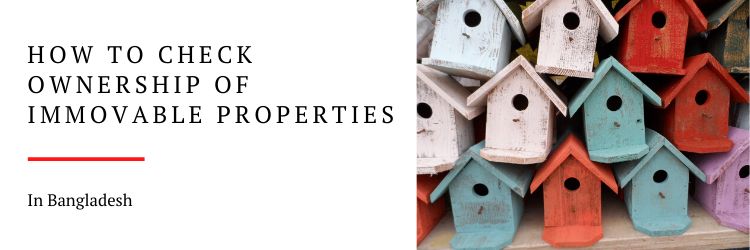The act of checking the ownership of immovable properties is an extremely indispensable and important undertaking that requires careful coordination and willful attention from all the parties to a sale, i.e. the buyer and the seller. It is only a matter of common sense, that the buyer needs to make sure that the person selling them something has in fact the right to sell it. In this article, we will focus on everything you need to know about checking or vetting the ownership of immovable properties in Bangladesh.

Contents
- 0.1 Why it’s important to check the ownership before the sale takes place:
- 0.2 The basics of ownership of immovable properties
- 1 How can you check the ownership of a property?
- 1.1 The First Step – Ask for the documents:
- 1.2 Second Step – Get a legal opinion on the property:
- 1.3 Third Step – Conduct a document search in the Sub-registry Office:
- 1.4 Fourth Step -Conduct further searches for encumbrances or charges:
- 1.5 Fifth Step – Conduct a search on the Tahsil Office
- 1.6 Sixth Step – Conduct a final search on the Land Office:
- 1.7 Seventh Step – Physically verify the property:
- 1.8 What if the seller is a Property Developer?
- 1.9 What else to keep in mind?
Why it’s important to check the ownership before the sale takes place:
The vast majority of the people in Bangladesh come from middle to lower-income backgrounds, people who work their whole lives to gather enough money to finally buy a piece of land in their name and settle down. But unfortunately, all this hard work can often be for nothing, if you do not put the same amount of effort in checking out the land before buying. The seller may give you a very convincing sales pitch regarding the infallibility of the transaction, but it is only possible that the property in question may be encumbered with mortgages or has some form of charge that will drastically hinder your own enjoyment. Since the property-related suits usually outlast a decade in the highly inefficient justice system of Bangladesh, costing such an unfortunate buyer a staggering amount of money, time and resources, the importance of verifying the property before the actual sale takes place cannot be overstated.
To check the ownership of immovable properties in Bangladesh, you can follow the steps outlined below:
- Collect property details: Gather as much information as possible about the property you want to check, such as the location, plot number, deed number, and current owner’s name.
- Visit the local Land Office: Visit the relevant local Land Office or sub-registry office in the area where the property is located. Each district has its own Land Office.
- Submit a request: Submit a written application to the Assistant Commissioner (AC) or the designated officer at the Land Office. Include the property details and your purpose for checking the ownership.
- Pay necessary fees: Pay any applicable fees for accessing the information or obtaining certified copies of property documents. The fees may vary depending on the specific request and the Land Office’s regulations.
- Verify ownership records: The Land Office will search their records and provide you with the necessary information about the property’s ownership. They may provide you with a certified copy of the property documents if requested.
- Online search (Optional): The government of Bangladesh is working on digitizing land records through the Digital Land Management System (DLMS). However, the online database is not fully comprehensive or available for all areas. You can check the DLMS website (https://www.dlrs.gov.bd/) to see if the property you are interested in is included in their database.
Please note that the process may vary slightly depending on the specific Land Office and the availability of online records. It is advisable to consult with a legal professional or seek assistance from a land surveyor who is familiar with the local procedures and can guide you through the process of verifying the ownership of immovable properties in Bangladesh.
The basics of ownership of immovable properties
Before you begin the actual checking, it is important to understand how the ownership of immovable properties works in Bangladesh. There are two major ways of owning immovable properties –
- By executing a registered document: As per the provisions of the Registration Act, 1908, documents relating to the transfer of immovable properties must be registered instruments. Therefore, if a person has taken ownership of the concerned property by way of sale, gift etc. then he must have done so by executing a registered document or title deed, and his name should be on the said document.
- By way of inheritance: If a person has taken ownership over the land by way of inheritance, then chances are that his name is not going to be present in most of the documents relating to the property, save for the corresponding mutation separation Khaitan. But the names of his predecessors, from whom he has inherited the property, should be present in the registered documents or Khatians etc.

How can you check the ownership of a property?
Going through the following steps and duly conducting all the tasks mentioned below before the sale, should provide you with adequate confirmation regarding the ownership of the seller and the existence of any charge or encumbrance that may pose any obstruction to your enjoyment of the property in the future –

The First Step – Ask for the documents:
The first step of checking ownership is to verify the documents through which the owner is claiming his title. As the prospective buyer, you have the right to ask the seller to show the following documents –
Title Deed: The title deed is the registered document through which you have taken ownership of the property you are trying to sell. If the property was transferred to you by way of sale or gift or by any other means, then it was definitely done through a registered document. This document will be instrumental in proving that you actually are the owner of the property in question. On the hand, if you took ownership by way of inheritance, then this does not apply to you.
Bia Deeds: Bia Deeds refer to the title deeds through which the previous owners had taken their respective ownerships over the land. Bia Deeds are invaluable in establishing a chain of ownership, which in turn establishes your claim over the land.
Khatians: Khatian basically translates to the “Record of Rights”. They are prepared through land surveys to determine the possession and ownership of land. Each Upazila is divided into multiple Jurisdictional Limits (J.L.), otherwise known as Mouza’s. Khatians are then prepared to divide further plots out of the Mouza to make a more precise assessment of who possesses which plot. Either your or any of the previous owners’ names will have to be recorded in the corresponding Khatians. Khatians by themselves do not confer any title over the property, but in conjunction with other documents, it can be valuable in proving one’s title.
The major Khatians that have been prepared as of yet include –
- C.S. (Cadastral Survey);
- S.A. (State Acquisition Survey);
- P.S. (Pakistan Survey);
- R.S. (Revisional Survey);
- B.S. (Bangladesh Survey);
- Dhaka City Jorip; and,
- Diara Jorip etc.
As for which of these Khatians are applicable in your case, will entirely depend upon the territory within which the property in concern is located.
4. Mutation Khatian: Mutation, also known as Namjari, basically refers to the mutation of the Record of Rights (Khatians) where the name of the new owner is updated over the previous one. Mutation is essential to prove one’s title to a property. Other than that, it is also important to create a holding for the purposes of paying ground rent in the name of the new owner. Since the matter of title deed does not apply to people who take ownership by way of inheritance, it is important to conduct the mutation procedure to establish their name as the new owner of the property.
5. Ground Rent Receipts: Property owners of Bangladesh are obligated by law to pay regular yearly ground rents to the corresponding land offices and in turn, are provided with these receipts upon payment.
6. Warishon Certificate: Warishon Certificates bear the general information regarding the successors of a deceased person such as their number, names, gender and how much of his immovable property they actually are entitled to inherit following his death. This certificate is a crucial piece of evidence for proving title for people who took ownership by way of inheritance and are usually issued by the local Ward Councilors Office, Chairman of the local Pourosova or Union Parishad etc.
7. No Object Certificate (NOC) & Non-Encumbrance Certificate (NEC): These certificates basically certify that your land has no encumbrances and therefore no one can object if you end up selling it. Collect these documents from the Sub-registry office that has territorial jurisdiction over your land.

Second Step – Get a legal opinion on the property:
Inspect the documents and contact your legal counsel to give a legal opinion regarding the property. Your counsel will examine all the applicable Khatians, starting from the oldest ones, and the Bia deeds to construct a chain of ownership of the property. This way you will understand from originally owned the land and how the rest of the successive owners claimed respective their ownership. In giving the legal opinion, your legal counsel will also point out the documents you need from the seller and whether there are any issues with the land or not.

Third Step – Conduct a document search in the Sub-registry Office:
The fact that the seller has duly shown the necessary documents to you does not in itself prove his title. It is now up to you as the buyer to conduct a document search in the corresponding Sub-registry Office and check whether the documents such i.e. the title deeds are in fact genuine.

Fourth Step -Conduct further searches for encumbrances or charges:
After you have satisfied yourself with the genuineness of the documents, you need to conduct another search on the same Sub-registry Office. Unlike the previous one however, this search will mainly try to find out the following things –
- If there have been any further transactions regarding the property since the seller took ownership;
- If there is any encumbrance or charge against the property by way of mortgage, loan etc.

Fifth Step – Conduct a search on the Tahsil Office
Afterwards, you should go to the corresponding Tahsil Office to verify that the owner has duly mutated the records in his name regarding the property.

Sixth Step – Conduct a final search on the Land Office:
You should also visit the corresponding land office and confirm that the seller has properly been paying the ground rent for the property. It is not possible to pay ground rent if there is any encumbrance or any other likewise issues with the property. So, if it can be confirmed that the seller has duly paid ground up to the latest year, you are halfway done in your search.

Seventh Step – Physically verify the property:
Assuming that you have had no problem in the previous two steps, you can promptly begin the physical verification. So far, we have only dealt with a property that exists in papers without actually confirming its tangibility, so do not be surprised if you find out after the sale that no such property actually exists in the real world. To counter After you are done checking out the papers, physically go to the property. Ask around the neighbourhood, cross-check all the particulars, verify the boundaries, find out if anyone else is claiming ownership of the property or not that is not in the papers, and do everything you need to do to satisfy the fact that the land is, in fact, suitable for purchase.

What if the seller is a Property Developer?
If the seller you have contacted is a property developer, you will have to go through the same procedures we just discussed above. However, we recommend that you keep an eye out for the following things –
- Find out everything you can about the nature and scope of their business. Inquire about their reputation and reliability for the sake of your own money;
- Find out whether the developer entity is an individual enterprise, a partnership association or a company. If it is any of the latter two, verify the legal authenticity of its incorporation through your legal counsel first. You can also go the extra mile and ask the developers to present you with their incorporation certificate.
- Peruse through the fine print of the agreement they are presenting to you and consult with your legal counsel before you sign anything. Make sure that you have an understanding with the developer entity regarding the following matters – a). The exact dates or period within which the developer plans to hand over the property to you; b) In case of delay in the handing over how they will remunerate you the buyer, either through interests or rents accrued from the property and at which rate such amounts will be paid to you. c) Receive and preserve only the properly signed and sealed money receipts for all the monetary transactions you make with the developer.

What else to keep in mind?
We did begin this discussion with the note that most if not all business relating to immovable properties in Bangladesh is arduous, to say the least. Even after going through all of these troublesome tasks to finally check the ownership of a property, there are still a plethora of matters that you need to keep in mind before you end up buying something, such as –
- Vested property: The land in concern may be a vested property that belongs to the government. Be mindful in your search at the Sub-registry Office, the Land Office and the Tahsil Office to make sure that this is not the case.
- Easement: As per the prevailing laws in Bangladesh, a right of easement may be created on a property by putting it to a consistent use for a certain amount of time, provided that the owner of the property has not refused to allow the said use. For example, if the previous owner of the property has allowed it to be used as a shortcut between two surrounding houses, consider the fact that you will have to allow the same as well. Keep an eye out for your physical inspections to figure out if there is any right of easement against the property.

Legal Advice regarding setting up a private limited company in Bangladesh by CLP:
The Barristers, Advocates, and lawyers at CLP in Gulshan, Dhaka, Bangladesh are highly experienced at assisting clients through the entire process and legal provisions relating to the sale of immovable properties and all the respective verification processes. For any queries or legal assistance, please reach us at E-mail: info@counselslaw.comPhone: +8801700920980. +8801947470606. Address: House 39, Road 126 (3rd Floor) Islam Mansion, Gulshan 1, Dhaka.

